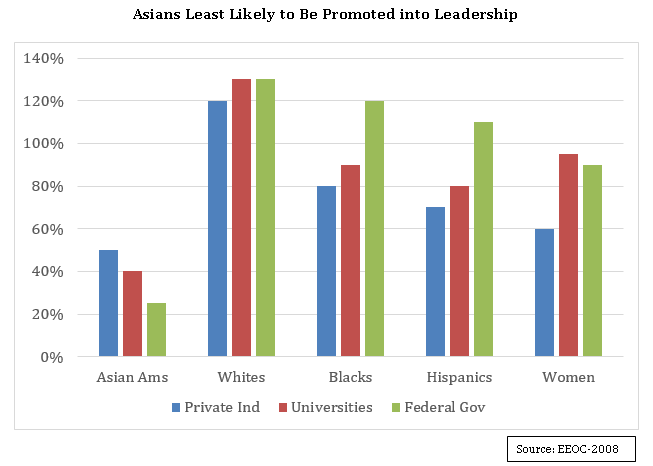
In 2008, EEOC conducted a study that showed Asian Americans are the least likely to be promoted into leadership positions behind women, African Americans and Latinos.

While the study did not highlight why, I speculate that some of the more Western admired leadership qualities may not be behaviors that are always explicitly displayed by Asians, depending on how much they may continue to adhere to traditional Eastern values. Consider this partial list of leadership characteristics that I compiled from various sources:
- Self-confidence
- Enthusiasm
- Communication
- Flexibility
- Ability to Inspire
- Decisiveness
When I think about the behavioral interpretation of these characteristics, self-confidence might be considered as boasting which would not be a positive trait in some Asian cultures. How does one demonstrate enthusiasm? In emotionally restrained cultures such as China and Japan, a visible display of emotion might be viewed as inappropriate especially for a leader. I often hear from clients that their Asian associates with accents are difficult to understand and are therefore considered to have poor communication skills. Culturally the US is considered one that is more open to risk taking while some Asian cultures are considered more risk averse. Behaviorally, flexibility might be interpreted in part as willingness to take risks. The ability to inspire might be interpreted as charismatic leadership and again in cultures where visible display of emotion is not acceptable, this characteristic might be judged as lacking. When we consider decisiveness, indirect communication style cultures might be interpreted as being indecisive because they may not provide a direct answer and expect the receiver to be able to read between the lines.
If we are not culturally competent, we might pass over good leadership capability because we have a narrow behavioral interpretation of what good leadership looks like.
What is the inclusion solution?
- Unpack the words and add specific behaviors that are associated with the leadership characteristics. For example, decisiveness might include something like “takes time to evaluate various options by gathering input from the team.” Another might be just the opposite: “is able to make effective on the spot decisions when necessary.” By including both behavioral interpretations, we acknowledge that decisiveness might look very different depending on the situation and also leadership style but both are valid.
- Don’t assume that Asian employees do not want to be developed just because they may not speak up and directly ask for a promotion or a different opportunity. Culturally it may be uncomfortable to directly advocate for themselves.
- Expand our notions of “good leaders.” Cannot good leaders lead quietly, unassumingly yet very effectively?


















